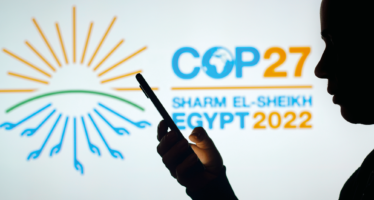Deloitte: Constructing a Sustainable Future in the Middle East
Towards the end of 2019, at the United Nations Climate Change (COP25) conference, the UN Secretary-General António Guterres warned that a “point of no-return” on climate change is “in sight and hurtling toward us.”

Against this warning, the World Economic Forum, an international organisation of political and business leaders reported in its 2020 Risk Report that, for the first time in the history of its Global Risk Perception Survey, climate-related issues dominated all of the top-five long term risks by likelihood among members of its multi-stakeholder community. These risks included extreme weather, climate action failure, natural disaster, biodiversity loss and human-made environmental disasters.
Given the link between Climate Change and human activity, international focus is leveled at industries that are significant contributors to greenhouse gas emission and users of energy.
According to the 2020 Global Status Report for Buildings and Construction, the buildings and construction sector accounted for 35% of final energy use and 38% of energy and process-related carbon dioxide (CO2) emissions in 2019.
With the Buildings and Construction industry being a key industry in the Middle East, what role can the industry play to reverse climate change?
“Over recent years, the industry has strived to understand its impact on the environment, innovate its methods and process and its resource use. In driving a sustainable industry across the Middle East, the construction industry has made considerable progress in its overall impact.’”
– Cynthia Corby Partner & Middle East Construction Leader, Deloitte
The Hidden Environmental Costs
The staggering amount of energy used, and the high levels of emissions produced by the industry is a result of the significant use of resources and the nature of its construction processes and production methods.
For example, as Chatham House, an International Affairs think tank reported, a key input into concrete, the most widely used construction material in the world, is cement. This is a major contributor to climate change as the chemical and thermal combustion processes involved in the production of cement are a large source of carbon dioxide (CO2) emissions. Each year, more than 4 billion tonnes of cement are produced, accounting for around 8 per cent of global CO2 emissions.
Not only does the industry’s use of energy and emissions release significantly influence Climate Change, but it also has a wider impact on the environment. According to the World Green Building Council, the industry accounts for more than 50% of all material extracted globally; and construction demolition waste contributes 35% to the world’s landfill.
Furthermore, the industry also contributes to noise pollution, changes landscapes and threatens biodiversity. The process of construction, often dangerous, also requires high levels of Health & Safety protection and regulations to ensure that workers’ welfare is protected.
“With its considerable environmental, social and economic impact and potential force for good, by embracing Sustainably at the heart of its processes, the Construction Industry is a very important ally in creating a Sustainable future for all.”
– Cynthia Corby
Once built and operational, buildings themselves also have an environmental cost, using electricity to power light, heating and air-conditioning, transporting water and waste.
As the output of the construction and real estate industry grows to meet demands of growing populations, so can its damaging effects.
Balanced against this however is the considerable social and economic benefit that construction brings in terms of infrastructure, housing, jobs, technological innovation and economic stimulus and development.
How Can Organisations Build and Construct Sustainably in the Middle East?
The premise of Sustainability is that it seeks to use and manage resources responsibly today in order to ensure the availability of resources for future generations.
Sustainable construction can be expressed as a number of principles focusing on:
- Minimising resource consumption (Conserve)
- Maximising resource reuse (Reuse)
- Using renewable or recyclable resources (Renew/Recycle)
- Protecting the natural environment (Protect Nature)
- Creating a healthy, non-toxic environment (Non-Toxics)
- Pursuing quality in creating the built environment (Quality)
This approach seeks to reduce the industry’s impact on the environment by utilising sustainable development practices, employing energy efficiency, taking advantage of green technology and processes, adopting the right health and safety processes and worker welfare concerns.
A UNEP report on Greening the Building Supply Chain states: “It has been estimated that in use, emissions account for over 80 percent of the total life cycle carbon emissions of buildings, with a further 15 percent of emissions embodied in materials and around one percent resulting from the construction process itself.”
As more energy-efficient buildings are constructed, more focus will be on alternate construction materials that reduce carbon emissions in their production and their use when the building is operational through creating a more ecofriendly building that needs less heating or cooling; and then the construction process itself, can reduce this through more ecofriendly processes.
Construction as a Stimulus
If building and construction is done in a sustainable way, the benefits are significant. Governments are not only seeing this industry as a stimulus for the economy but also an opportunity to significantly affect climate change.
Many Middle Eastern countries are focused on activities to try and mitigate climate related impacts.
In Saudi Arabia, the government has created the National Transformation Project and the Vision 2030 strategy to innovate and diversify, providing a foundation to underpin the integration of sustainable development goals into the national planning process. It is planning to invest approximately USD1 trillion in the country’s non-hydrocarbon sector by 2030. Some of the key projects include Neom, the Red Sea Project, Qiddiya Entertainment City, King Abdullah Financial District and Amaala.
The recently launched Saudi Green Initiative and Middle East Green Initiative, are two large scale initiatives that are ‘defining an ambitious road map that rallies the region and significantly contributes to achieving global targets in confronting climate change.’
Faced with growing desertification, increased air pollution and threats to marina and coastal environments, the initiatives seek to rehabilitate 40 million hectares of degraded lands, generate 50% of Saudi Arabia’s energy from renewables by 2030, and raise the rate of waste diversion from landfills to reach 94%. Through coordination with neighboring countries of the Gulf Cooperation Council (GCC) and other Middle East countries, the initiative will extend rehabilitation to 200 million hectares of degraded land.
In the UAE, the world’s largest single-site solar project, Noor Abu Dhabi covers an area of 8 kilometers and features 3.2 million solar panels. The project enables increased production of renewable energy and reduces reliance on the use of natural gas for electricity generation resulting in a carbon footprint reduction of 1 million metric tons per year, which is equivalent to taking 200,000 cars off the road.
Other significant alternative energy projects in the UAE include the Al Dafra Solar PV plant, which is expected to provide approximately 160,000 households across the UAE with electricity when finished; and the Mohammed bin Rashid Al Maktoum Solar Park, which is a phased project delivering a variety of photovoltaic and Concentrated Solar Power technologies, and, when completed, will save over 6.5 million tons of carbon emissions annually.
Expo 2020 Dubai, the international exhibition show-casing scientific, technological, economic and social progress, is set to be the ‘cleanest and greenest’ world exposition ever staged in October 2021. There are clean energy solutions powering the expo site together with recycling and reusage programmes. The key buildings are LEED Gold-certified, ensuring they meet the highest sustainable construction standards, and 85% of all waste generated during the construction of the site and during the event itself will be recycled. When the six-month-long exhibition is finished the site will be developed into District 2020 – a dedicated mixed-use business hub that will promote and foster innovation. It is anticipated that more than 80% of Expo 2020’s built environment will be repurposed in the transition to District 2020.
In Qatar, preparations for the FIFA 2022 World Cup continue as the eight sports stadiums which will host the matches are being built with high levels of energy and water efficiency, to provide legacy buildings with year- round use. Extensive use of modular design will enable 170,000 seats to be relocated to countries that lack sporting facilities; and one building is the world’s first ‘dismountable stadium’, enabling its parts to be repurposed after use and the land redeveloped into a waterfront development.
Substantial visionary infrastructure investments such as these, coupled with sustainable construction principles, have the potential to allow the industry to help mitigate Climate Change. By building in energy and water efficiency, waste recycling and green technology into projects, these initiatives will bring many sustainability benefits throughout the project lives. Contractors will, however, still need to be careful and consider the wider impacts of construction on natural environments to justify the development and ensure an appropriate balance is achieved.
About the Author

Author: Damian Regan Deloitte Middle East Assurance Leader for Sustainability
Damian Regan is currently based in Dubai, UAE, having spent the last four years working across the Middle East and over 20 years in London, UK. He has worked within International Accountancy firms during his career and assists clients understand their contribution to society and the environment. In particular he assists them in effectively communicating and reporting their sustainability goals, results and impacts. He also works with industry bodies and regulators to help develop standards of sustainable practices, reporting and assurance.
About Deloitte & Touche
Deloitte & Touche (M.E.) LLP (“DME”) is the affiliate for the territories of the Middle East and Cyprus of Deloitte NSE LLP (“NSE”), a UK limited liability partnership and member firm of Deloitte Touche Tohmatsu Limited, a UK private company limited by guarantee (“DTTL”). DME’s presence in the Middle East region is established through its affiliated independent legal entities, which are licensed to operate and to provide services under the applicable laws and regulations of the relevant country. DME’s affiliates and related entities cannot oblige each other and/or DME, and when providing services, each affiliate and related entity engages directly and independently with its own clients and shall only be liable for its own acts or omissions and not those of any other affiliate. DME provides Audit and Assurance, Consulting, Financial Advisory, Risk Advisory and Tax services through 27 offices in 15 countries with more than 5,000 partners, directors and staff. It has also received numerous awards in the last few years which include, Middle East Best Continuity and Resilience provider (2016), World Tax Awards (2017), Best Advisory and Consultancy Firm (2016), the Middle East Training & Development Excellence Award by the Institute of Chartered Accountants in England and Wales (ICAEW), as well as the best CSR integrated organisation.
You may have an interest in also reading…
Princess Ameerah Al-Taweel: Saudi Princess at Forefront of Women´s Lib – “We Want Change”
It is quite difficult to introduce Ameerah Al-Taweel without mentioning the fact that she is the wife of Saudi Prince
UNCDF: COP27 Pledges Biodiversity Finance to Boost Climate-Change Resilience
Forests, coral reefs and populations most at-risk come into focus at 2022 summit in Egypt. “From the beginning, this conference
Building Stronger Governance and Compliance Foundations in Sub-Saharan Africa
Analysts, politicians, economists and media pundits have kicked off 2016 with a largely pessimistic outlook for the global economy. Clearly


















































































